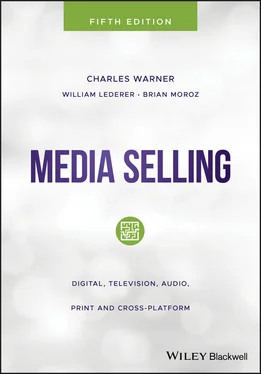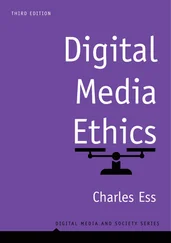1 ...7 8 9 11 12 13 ...36 Karmazin’s CBS salespeople sold advertising based on the theory that advertisers “paid their money and took their chances.” 4 Advertisers did not know if their ads were going to work, and salespeople sold on the basis of emotions, relationships, and scarcity, not return‐on‐investment (ROI) metrics. However, the Google executives thought they could design a better system, one that was measurable and fair to all advertisers, not just to big advertisers. Karmazin could not believe what he heard from the Google executives, and he said, half in jest, to paraphrase his actual words, that they were messing (not his actual word) with the magic! 5
Indeed, Google’s AdWords ii was not magic, it just reaffirmed how the Internet had disrupted advertising, marketing, the media, and the fundamentals of all media businesses, as indicated in Chapter 1in the discussion of the value chain and aggregation theory.
A 2018 article in the Harvard Business Review titled “Ads that don’t overstep” articulated how the Internet changed marketing and, thus, changed how media is sold:
The Internet has dramatically expanded the modern marketer’s tool kit, in large part because of one simple but transformative development: digital data. With users regularly sharing personal data online and Web cookies tracking every click, marketers have been able to gain unprecedented insight into consumers and serve up solutions tailored to their individual needs. The results have been impressive. Research has shown that digital targeting meaningfully improves the response to advertisements and that ad performance declines when marketers’ access to consumer data is reduced. 6
Mel Karmazin’s magic has been replaced by data, which some experts have called the new oil , and which has made buying and selling media infinitely more complicated than it was before the Internet allowed marketers to micro‐target consumers based on their Internet browsing and searching behavior and their intention to buy a product.
Complex digital‐era selling requires new assumptions and approaches to media buying and selling, which we will examine in this chapter.
Digital‐Era Media Are Still “The Media”
Even though the Internet spawned new ways to create, publish, and distribute news and entertainment content and new ways to buy advertising programmatically, the newly created media platforms such as Google and Facebook are still perceived to be “the media” by the public. The media, including digital media, are ubiquitous and powerful, and they transmit advertising, political, cultural, social, and moral messages (either intended or unintended) to a mass audience. Over the years “the media” has been under attack from both the right and left of the political spectrum. In the 1960s, as you learned in Chapter 1, Theodore Levitt defended advertising from critics who thought it was creating a materialistic society. In the 1970s, conservative hawks accused “the media,” particularly television, of vilifying the military and for the loss of the war in Vietnam. In the 1990s, liberals and Democrats accused “the media” of prosecuting President Bill Clinton. In the 2016 presidential election “the media” were accused of distributing fake news, especially by Donald Trump.
However, “the media” is not a single, monolithic entity. Media is a plural noun that includes a multitude of outlets – television, digital platforms, radio, newspapers, magazines, out‐of‐home advertising (billboards and posters), and digital and printed newsletters – that communicate in a multiplicity of voices, political orientations, and opinions.
Because of the complex and fuzzy combination of show business and public service, the media have always been and will continue to be loved and hated, praised and vilified, regulated and deregulated, and given credit or blamed for everything from keeping our nation free to poisoning the minds of our children. Salespeople in the media must learn to deal with all types of extreme reactions and to accept the fact that they, as representatives of their medium, will have to face these, often highly emotional, reactions on a daily basis.
The good news is that, as a salesperson for a medium, you will often have easy access to clients. The bad news is that your medium will be blamed for everything from a client’s sore back to the election of an unpopular president, and you will have to listen to the reasons for your medium’s and all of the media’s failures. Many people tend to lump all the media together as a monolithic target for their anger, so it does not matter if you are selling for a website, a television network, a radio station, or a newspaper, you will probably get comments about how awful the media are. You will have to learn to listen non‐defensively, not to take insults personally, and to respond unemotionally and good‐naturedly to criticism.
New Assumptions for the Digital Era
The media industry is changing at an accelerated rate in terms of both technological advances and the audience’s tastes and needs. As America continues its transition from a production‐oriented, analog economy to an information‐oriented, digital economy, consumers become more informed and more selective.
Assumption 1: The media are fragmented
In the past, the traditional media enjoyed virtually guaranteed profits, but today the media are becoming increasingly fragmented because of the disruption caused by the Internet. There is a plethora of media, especially digital media, chasing smaller and smaller market segments. As the audiences of traditional media such as newspapers, magazines, and television decline, the audience of digital media is exploding. Google, Facebook, Amazon, and other digital and mobile advertising‐supported businesses are growing and, thus, gobbling up more and more of the available advertising dollars. Therefore, profits are declining in most of the traditional media as well as in marginal digital media. However, as the competition for advertising dollars increases, the need for effective salespeople increases.
Even though sales jobs at radio and television stations have declined in many markets, and sales jobs in newspapers and magazines have been reduced dramatically, sales positions in digital and mobile companies have exploded, so that the total number of media sales positions in America has increased overall. Also, media fragmentation has resulted in it being more difficult for the salespeople of smaller media companies and publishers to get traction with marketers and advertising agencies. Therefore, more and more small and medium‐sized publishers are turning to selling their advertising inventory programmatically and, thus, are reducing their sales forces. On the other hand, sales jobs in data analytics companies, consultancies, exchanges, and platforms such as Google and Facebook have increased. There have never been so many opportunities for competent salespeople in the media; and yet today, selling is more difficult, complex, and competitive than ever before. To succeed, you must be better trained, better prepared, and better educated than was the case in the past.
Assumption 2: Automation changes the sales process
Over 80 percent of all digital ad inventory is sold on an automated basis, or programmatically. Programmatic refers to the real‐time bidding (RTB) for an available online ad impression by a demand‐side (advertiser) algorithm, the acceptance of a bid by a supply‐side (media) algorithm, and the serving of a digital ad. This bid‐ask–purchase–ad‐serving process takes place while an ad impression is loading on a laptop or smartphone screen in 200 milliseconds, or in the blink of an eye. Chapter 17explains in detail how programmatic buying and selling of ad inventory works.
Читать дальше












